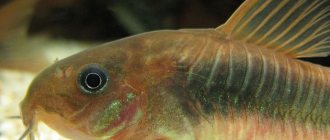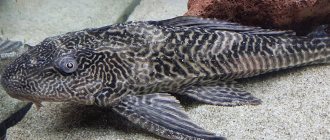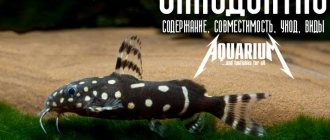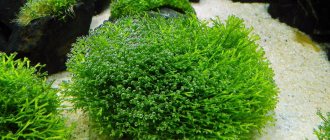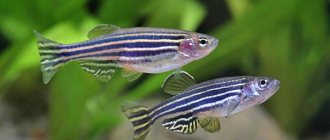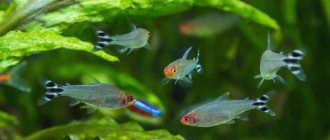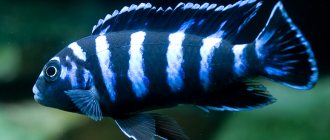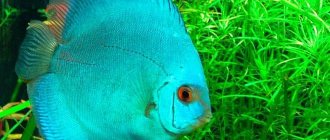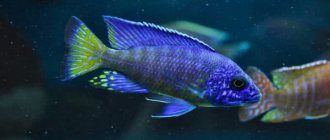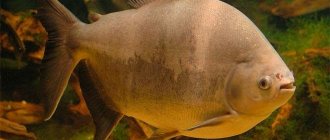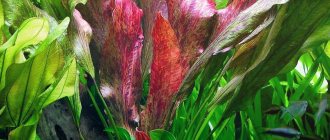The peaceful bottom fish Corydoras panda is not very common in nature, which is why it is more expensive than other catfish of this family. Easy to care for and undemanding when it comes to nutrition, the Corrida has captivated aquarists with its unusual color. Wild individuals are rarely found on sale, mostly artificially bred.
The origin of the fish explains its ability to tolerate low water temperatures. The rivers of South and Central America originate in the mountains. Melting snow often cools the water. The panda corridor is found only in clean rivers with sandy soil and abundant vegetation.
Description
The catfish received the name panda in 1971 for its similarity in color to the bamboo bear.
The elongated body is covered with horny scales. There are small shields near the eyes, as well as on the dorsal and adipose fins for protection. Like other corydoras, the panda has 3 pairs of antennae.
Appearance
The body is high-backed, pale pink or light in color with three black spots:
- around eyes;
- on the dorsal fin;
- on the side closer to the tail.
The remaining fins are white-yellow.
In different lighting conditions, the fish takes on a yellow or green iridescent tint.
Adult pandas often reach size 5, less often 5.5 cm.
Behavior
Panda catfish are bottom dwellers. They are active in the evening and after turning off the lights. They spend most of their time at the bottom. They love to dig in the ground. Pandas don't live alone. Buy them in flocks of 3 or more.
View this post on Instagram
Catfish Corridors Panda?. The inhabitants of my aquarium. Very cute and harmless fish? #aquarium #aquarium science #catfish #corridoras #corridoraspanda
A post shared by Nadezhda (@happy.life3776) on Mar 21, 2022 at 7:46am PDT
Lifespan
In captivity, panda catfish live up to 10 years. There are several known cases when the life expectancy of Corydoras reached 12–13 years.
Feeding
Panda catfish is an omnivorous fish, unpretentious in terms of food choice, and therefore it is quite easy to care for it.
Suitable live food is: cyclops, shrimp, worms, tubifex, brine shrimp, mosquito larvae, daphnia, etc. Regarding dry food, we cannot fail to mention special tablets and granules for bottom fish.
Corydoras Panda should be fed in the evening, when their activity increases significantly. Since the catfish is a demersal fish species, it is necessary to ensure that competing individuals from the upper strata of the water space do not interfere with this process by eating the food before it reaches the bottom.
Content
Corydoras sold in pet stores are bred in captivity and adapt well to new conditions. Breeding and growing by beginning aquarists is possible.
Aquarium
For a group of 3–5 catfish you need an aquarium with a volume of at least 40 liters. Choose a low container, about 40 cm. When kept together with other fish, pay attention to the bottom area. Optimally 100 cm long by 40 wide.
Water parameters
Corridors are demanding regarding the condition of water. Maintain the specified parameters in the aquarium:
- acidity – pH: 6.0–7.0;
- water temperature – 20–25 °C;
- hardness – 2–12 dGH.
Pandas bred in captivity can withstand cold temperatures of up to 12 degrees.
Perform water changes once a week.
Plants
When choosing plants, give preference to those that float and create shade. In the underwater flora, catfish are not whimsical. What is more important for them is the presence of places where they can hide. Be sure to arrange a large number of shelters from snags, stones, and tree roots.
Priming
Cover the bottom with fine sand or gravel, fraction up to 3 mm. The soil needs to be smooth, otherwise the pandas will hurt their whiskers.
Equipment
Filtration and aeration are required. Create a moderate current. If the fish rise to the surface, add aeration.
Lighting
The fish is undemanding when it comes to lighting. Nocturnal in nature, they prefer to spend time in the shade.
Panda catfish - causes of death
Aquarium inhabitants require good care. If the panda corydoras catfish is bred incorrectly and without paying attention to temperature and nutrition, then the beautiful creatures will quickly get sick. We list the main reasons for the death of these fish:
- Poor water quality.
- Overpopulation of the aquarium.
- A drop in temperature above or below normal.
- Use of spoiled feed.
- Presence of harmful organisms.
- Water changes are carried out rarely or with irregularities.
- If the fish gets into a new aquarium with a different water composition, it may not survive acclimatization.
Compatibility
Catfish are schooling fish. They move around the aquarium in a group.
Pandas are peaceful by nature and get along well with other inhabitants of the aquarium. Suitable neighbors:
- tetras;
- zebrafish;
- barbs.
Well compatible with other aquarium catfish.
View this post on Instagram
Friends forever ? Friendship. Forever friends? ____ friends#plecostomus
A post shared by Mankinyrybki (@mankinyrybki) on Feb 8, 2022 at 11:01pm PST
Neighborhood with large aggressive fish is not advisable, for example:
- tiger barbs;
- goldfish.
General information
Panda catfish is a school creature. Usually the fish do not leave the group ( it is better if there are at least 6 individuals in the school ). The fish have been known since 1968 (then they were acquired by collector Randolph Richards), but they received their name only 3 years later.
It is almost impossible to find wild specimens for sale. The commercially available catfish are bred on farms in Eastern Europe and the Far East.
Interesting! The veiled panda was bred just a few years ago by German breeders. This variety is distinguished by its elongated tail fin and golden sand color.
Reproduction
Pandas are easy to breed. If you follow the basic rules of care, the aquarium will soon be replenished with new inhabitants.
Sexual maturity occurs at the age of 8–10 months.
Sex differences
- Females are larger than males.
- The line of the underbelly in the female is rounded, while in the male it is smooth.
- When viewed from above, females are wider.
- Males have a more pointed dorsal fin.
Spawning
Equip a separate aquarium for spawning:
- soil – fine-grained sand;
- vegetation – moss;
- temperature is the same as in the main aquarium;
- It is advisable to filter through peat.
Place two males on one female. Increase the amount of live food. When the female’s abdomen is noticeably rounded, cool the water by 1–2 degrees and increase filtration. Such conditions will be closer to natural and will stimulate spawning.
When the eggs are ripe, mating games begin. For fertilization, the fish take the T-shaped position characteristic of all representatives of Corydoras. The eggs are spooled onto plants or the walls of the aquarium. Spawning continues for several hours. In total, about 100 eggs are exhausted.
After spawning, remove the fish and add a few drops of methylene blue. This procedure will reduce the risk of fungus developing on the eggs.
Some types of shrimp, such as Cherries, cope best with the fungus.
The fry hatch in 3–5 days. The characteristic coloring of the breed will fully appear at the age of 2–3 months.
Ciliates or special food are suitable for feeding the fry. After 2 weeks, you can add mashed yolk to the diet. At the age of a month - live food of larger size.
Caring for fry is the same as for adults, but water changes should be the same as in the first month of life.
Attention! Before hatching, the temperature should not rise above 22 degrees.
Diet features
The fish are completely unpretentious in nutrition: they eat live, frozen and dry food with appetite.
Since fish live on the bottom, you need to choose sinking food, for example, special for catfish.
Favorite delicacies : daphnia, tubifex, bloodworms and brine shrimp.
It is preferable to feed in the evening , since Corydoras are more active at night and spend their days hiding in shelters.
Diseases
Corydoras panda catfish do not have strong immunity and are susceptible to many diseases. Place each purchased fish in mandatory quarantine. Add a few drops of a disinfectant such as Antipar to the container and keep it in the novice solution for at least 2 days, preferably a week.
The most dangerous diseases are:
- Parasitic. Visible to the naked eye. White spots appear on the body and fins. The treatment is to increase the temperature in the aquarium.
- Bacterial. Serious illnesses cannot be treated, and the fish dies. Mild cases such as fin rot require the addition of antifungal agents to the water or feed.
- Viral. If the lymph nodes are enlarged and plaque appears around the eyes, consult your veterinarian. Mild degrees of the disease can be quickly treated with medication. When the color changes to dark and the pet becomes generally lethargic, the survival rate is low. This is an indicator of iridovirus infection. There is no cure for it.
Like other fish, pandas most often get sick from improper care or water contamination.
Attention! Do not use salt baths or preparations with high copper content in treatment.
Homeland
The homeland of this species of corydoras is Peru and Ecuador, the Ucayaki River and Rio Aqua, Rio Amaril. The water in these rivers is acidic and soft, and the current is quite fast. The bottom is sandy, with many different plants. Thanks to the meltwater that flows into rivers from the Andean mountains, fish can easily withstand temperature fluctuations from 16 to 28 degrees. It is recommended to keep catfish in an aquarium in water with a temperature of 22-26 degrees.
Photo
Reviews
The panda fish is loved by aquarists for its peaceful disposition and unique color. Disadvantages include secrecy and nocturnal lifestyle.
Choosing the right healthy catfish in the store
When buying Corydoras catfish in a store, pay special attention to:
- Are there sick fish in an aquarium with Corydoras?
- The behavior of the Corydoras himself. Is it active? A healthy fish moves actively, swims to the surface, grabs air, and easily swims to the bottom. Patients move chaotically, fall to the side or simply lie motionless at the bottom. There is a feeling of hesitation in the movement.
- No damage to the mustache.
- Red-brown spots on the body or fins indicate the presence of bacteria or fungi.
- Sick catfish have fins that are stuck together or covered with rot.
- A sunken belly indicates worms.
- The eyes of a healthy fish are clear, without films or cloudiness.
- Do not pick up catfish with red or inflamed gills. Possible nitrate poisoning.
If you plan to breed corydoras and buy several pieces, take fish of different sizes - you are more likely to get fish of different sexes.
Adviсe
- When changing water, also clean the soil. Pandas don't like pollution.
- Fish prefer dark-colored sand to light-colored sand.
- Dry oak or beech leaves are beneficial for the health of catfish.
- Catfish will get along with all peaceful fish and even shrimp.
- It is optimal to use Java moss for spawning.
- Some sources indicate that catfish can live in a small container. This will cause discomfort to the fish, adhere to the recommended parameters.
- In fry up to 3 months the color is not expressed. Don't go wrong with the breed when purchasing.
Peaceful, hardy and easy to keep, the panda catfish is suitable for beginner aquarists. Thanks to its unusual color, the catfish has confidently occupied a niche among popular fish.
Previous
Fish Barbus mutant - a fish with a peculiar character
Next
FishBright cichlid Flowerhorn (flowerhorn)
Origin and distribution
The popular species Corydoras comes from Peru, where it is found in the river basin. Ucayali - in one of the sources of the Amazon. It was discovered by G. R. Richards in 1968, but was not named until three years later. The name was given in honor of the Chinese giant panda. Surprisingly, the attractive catfish imitates the coloring of this animal.
The area from which Corydoras Panda originates is known for its neutral, slightly acidic water, soft due to a lack of minerals. These waters are cooler than other tropical areas.
When this fish was first discovered, it was quite expensive to purchase.
Captive breeding programs for the Panda Corydoras have yielded results and significantly reduced the price. As a result, it has become not only quite inexpensive, but also extremely popular.
